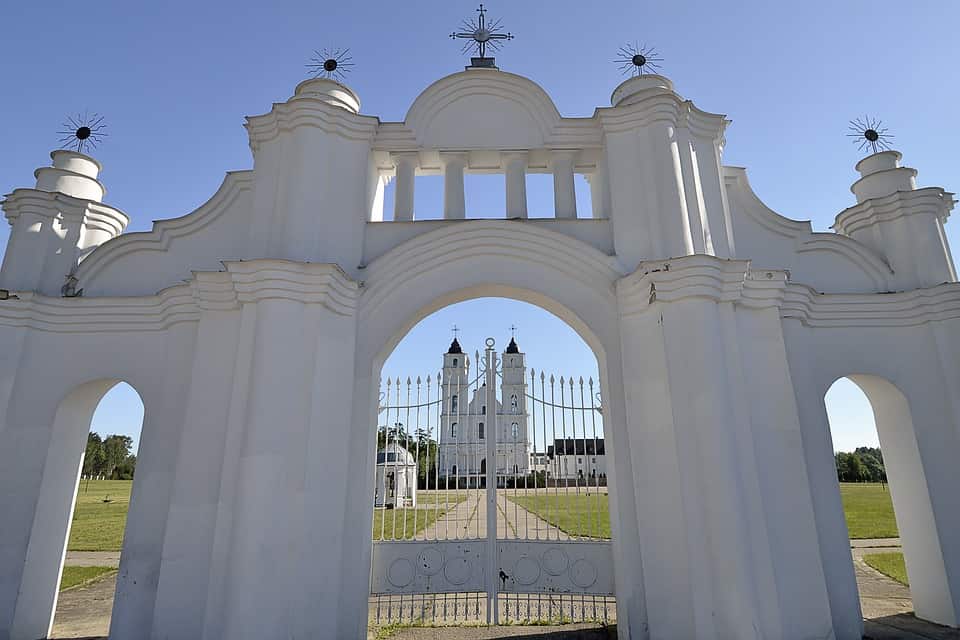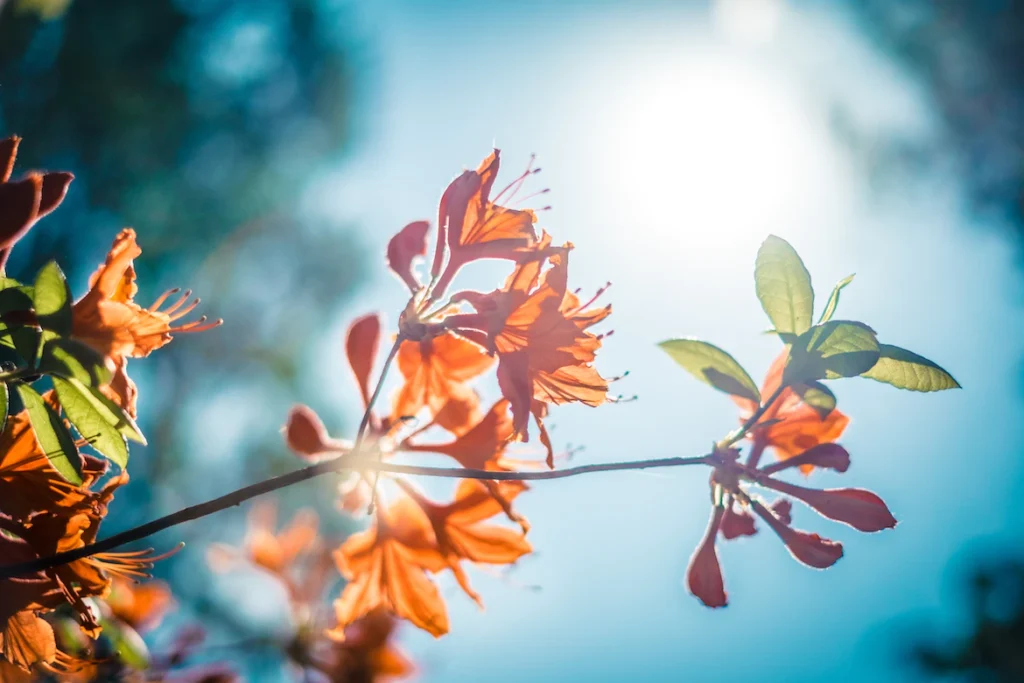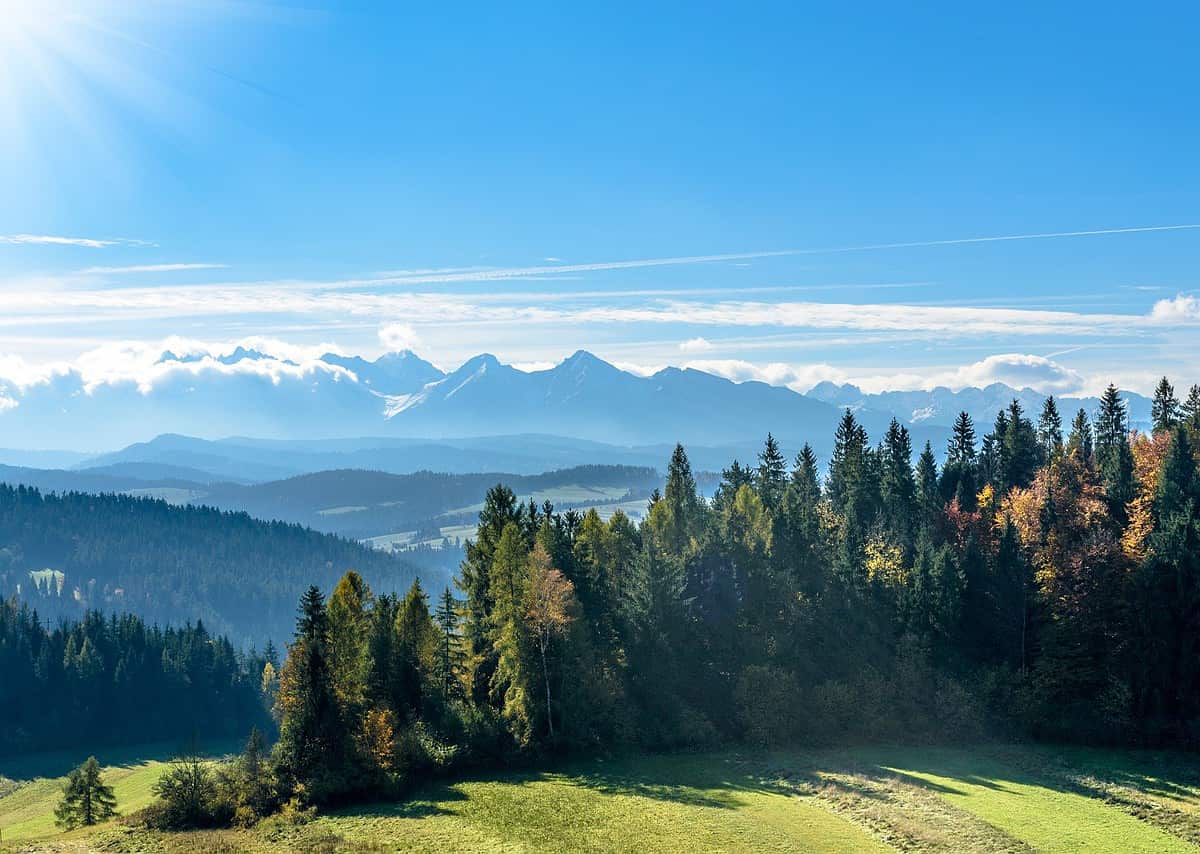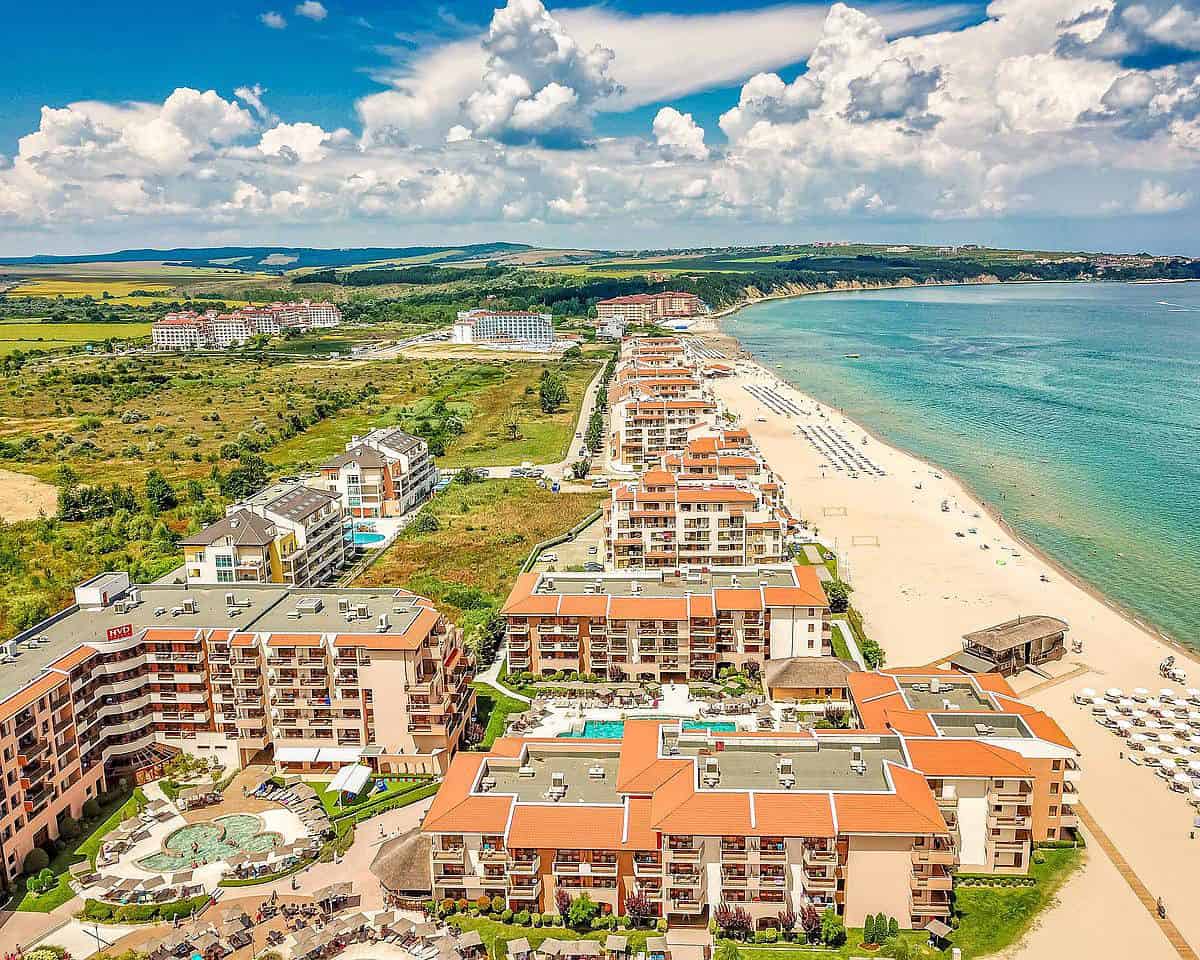If you want to explore some of the best Latvia landmarks, you’ve come to the right place! Latvia is a small country tucked away in the Baltic region of Eastern Europe. It may not be the most famous country to travel to in Europe, but once you visit, you’ll realize this tiny country should have been at the top of your list.
Latvia is full of surprises, and while it may not be a big country, there are enough things to do here to keep you occupied for weeks! Here are the best landmarks in Latvia to add to your bucket list.
More European Landmarks – MOST FAMOUS LANDMARKS IN EUROPE
Latvia Landmarks
Latvia is a country in the Baltic region of Northern Europe. It shares borders with Estonia to the north, Lithuania to the south, and Russia to the east. It also has a coastline along the Gulf of Riga, which is part of the Baltic Sea.
#1 Town Hall Square

Town Hall Square (Latvian: Pilsētas laukums) is a square in the beautiful old city of Riga, Latvia. It is one of the city’s most important and central squares, located right in front of the City Hall.
Town Hall Square was created during the 19th century when it was decided to build a new city hall and expand the streets towards Dome Square. The building of the Town Hall was finished in 1887 and has been used as a city hall since then.
Buildings from different periods surround the square: from medieval times, only a few buildings are left.
#2 Bauska Castle
Bauska Castle is a medieval castle located in Bauska, Latvia. The castle is one of the country’s most important cultural and historical monuments. It was built due to the Livonian War and is still used by the military.
The Bauska Castle was built in place of an older wooden fortification around 1250. The castle was built on a hill overlooking the town of Bauska and had four towers — two on each side, connected by a wall with loopholes for archers. A drawbridge protected the entrance over a moat.
#3 Turaida Medieval Castle
This magnificent building was built between 1793 and 1795 for the noble family of Counts of Tauentzien. The castle was created by a local builder and architect, Karl Friedrich Schinkel, who also designed the famous Schloss Bellevue in Berlin. The castle was reconstructed during the second world war.
A beautiful park surrounds the castle. The park contains many interesting architectural elements,, such as an artificial waterfall, an oval pond, and several other smaller ponds with fountains.
The castle has been used as a museum since 1949, where you can see different exhibitions on different topics.
#4 Daugavpils Fortress

Daugavpils Fortress is an old fortress in Daugavpils, Latvia. It was built in 1577-1580 by order of Tsar Ivan the Terrible to protect the eastern border. The defence has a pentagonal shape, with five bastions and moats on each side.
There were two gates leading to it: Sokolovskaya and Shirokaya Gates. From the 17th century until 1918, it was called “Dvina”.
The fortress is fascinating not only for its history but also because it hosts several museums: A history museum, Natural science museum, and an Art museum. You can also find a city park with lakes and flowerbeds, beautiful walking paths, and many cafes where you can sit down for a cup of coffee or tea.
#5 Riga TV Tower

Here comes the most interesting for kids attraction of Riga, Latvia – the TV tower. It is a magnificent building with an observation deck and several restaurants. The observation deck is located on the top floor of this structure which is 250m high. The tower was built in 1975, and it can be seen from any point in the city. It is one of the most famous landmarks of Latvia.
Thesymbolizesin Riga is an open-air observation platform that offers amazing views of the city centre and the surrounding area. You can see as far as other Baltic countries like Estonia, Lithuania, and Russia. If you want to get up there, it’s best to go early in the morning because once it gets dark, it can be hard to find your way back down again!
There are two ways to reach this destination: by foot or by using the lift. You must pay for both options separately, so keep this in mind when deciding how to visit the observation deck! Also, ensure you don’t forget your camera, as there will be plenty of amazing photo opportunities up there!
#6 Edole Medieval Castle
This castle was built in the 13th century and is located in the central part of Latvia. The Livonian Order once owned the castle, but today it is used as a hotel and restaurant. It is also known as “the little Versailles” because it has a similar architectural style.
#7 Ventas Rumba
This waterfall is located near the town of Sigulda and is one of the most popular attractions in the country. It is about 30 meters (100 feet) high, and several hiking trails through the surrounding forest lead to it.
The waterfall can be reached by following a short path off Highway A9 that leads into the woods behind Hotel Ventas Rumba resort.
#8 Saint Peter’s Church

This incredible building was built in 1209 and still stands today as one of the oldest of Riga’s Cathedrals Monuments. It is also known as “Riga Cathedral” because it was used as an Orthodox church before becoming Catholic during the Reformation.
#9 Rundale Palace
Rundale Palace is a combination of several different buildings that date back to the 18th century. Rundale Palace was turned into a museum in 1916 and now features exhibits covering Latvian history from ancient times to the present.
The palace also houses a collection of historical artefacts from around Latvia, including paintings by masters of Latvian art like Rihards Zariņš and Jānis Kļaviņš.
#10 Rumbula Forest Mermaid
Rumbula Forest Mermaid (Latvian: Rumbulas meža krastu saliņa) is a mermaid sculpture on a rock located in the centre of Riga, Latvia, near the former site of the Rumbula massacre during World War II.
The sculpture commemorates victims of the Holocaust and their fate in the nearby forest. It was designed by Māris Sirks, commissioned by businessman Andris Šķēle and erected in 2005.
#11 House of the Black Heads – A Magnificent Building in Latvia
The House of Blackheads (Latvian: Melngalvju nams) is a medieval building in Riga, Latvia, that was once home to an important guild of merchants and traders called Lettish German Blackheads (Lettiskie melngalvi). Today it houses a restaurant and museum dedicated to this history.
#12 The Freedom Monument

This monument commemorates Latvian freedom fighters who fought against foreign powers during World War I and II. Located in front of the Riga City Council building, it was designed by sculptor Kārlis Zāle in 1935 and unveiled on November 18th, 1935, by President Kārlis Ulmanis. It consists of a column surmounted by a woman holding three stars representing The Sun (liberty), The Moon (hope), and The Star (faith).
#13 Nativity of Christ Cathedral
The Nativity of Christ Cathedral is located in Riga, Latvia’s capital city. The cathedral was completed in 1773, making it one of the oldest buildings in the city. The cathedral has undergone several restorations since its initial construction.
It has also been damaged by fire several times throughout its history, including twice during World War II when it was used as a storage facility for Nazi ammunition. Today, the cathedral is still used as a place of worship by many different denominations, including Catholics, Orthodox Christians, and Lutherans.
#14 Jelgava Palace
Jelgava Palace was built during the reign of Peter the Great for Catherine I, who ruled Russia from 1725-1727 before she died unexpectedly at age 45.
She had only been empress for seven years when she died unexpectedly while visiting her son Peter II in Jelgava, Latvia, where he served as governor-general of Russian forces fighting against Sweden during the Great Northern War (1700-1721).
Peter II (1672-1730) never married but did have several illegitimate children with his mistress.
#15 Jurmala

The actual gem of Latvia is the resort city of Jurmala, which is located on the Gulf of Riga. Here, the first resort towns started to emerge in the 18th century, and by the 19th century, most of the city’s districts had attained resort status.
If you visit this remarkably attractive city, Jurmala, which has been a popular destination for pleasure for more than 200 years, you’ll undoubtedly find something to see in Latvia.
More than 400 structures with different orientations are included in Jurmala’s list of Latvian sights. The facades of the buildings are a defining aspect of its architecture, beautifully embellished with lace carvings on wood.
There are many options for attractions, and the list might go on forever.
#16 Ducal Palace
The Ducal Palace is the grandest Baroque palace in Riga, Latvia. It was built in Neoclassical style by architect Francesco Bartolomeo Rastrelli between 1748–1753 for the newly formed Baltic nobility of the city.
The palace was severely damaged during World War II and rebuilt in 1953–1958. The building currently houses the Latvian National Museum of Art, displaying its permanent collection of 19th-century paintings and sculptures by European artists.
The palace occupies an area of about 5,000 m² (54,000 sq ft), with a total of 39 rooms on three floors. The exterior is decorated with Rococo elements such as columns, gables, and sculptures. The central part of the facade has two stories and is topped with a triangular pediment containing an equestrian statue of Peter I of Russia by Francesco Rastrelli.
The second story has windows framed by pilasters that extend to form balconies above them.
#17 Sigulda Castle

The UNESCO-listed Sigulda Castle sits high above the Gauja River in the Gauja National Park. It dates back to 1211, when it was built by Bishop Albert von Buxhoeveden, who also founded Riga. Today it’s still used for summer festivals and concerts, with its stunning architecture making it one of Latvia’s most popular attractions with the most amazing sunset.
#18 The Gauja National Park

The Gauja River Valley is home to several castles, including Turaida Castle near Sigulda, which has been described as one of Europe’s ‘most unusual’ attractions sights due to its distinct architectural style that combines Gothic and Baroque elements with traditional Latvian motifs such as animal heads on railings or gargoyles on roofs.
#19 Central market Riga

Latvia’s central market is one of its oldest buildings, dating back to 1786. Today, it houses over 300 shops selling everything from clothing to flowers. Visitors can also enjoy weekend live music performances at this popular attraction in Old Riga.
#20 City of Kuldiga

Kuldiga is located in Western Latvia and is known as the “Little Paris of Latvia”. It was founded in 1211 but was destroyed by the Livonian Order.
This beautiful medieval town on the Baltic coast has been inhabited since 8000 BC, making it one of the oldest settlements in all of Europe. The town was originally known as Kalevipils (or “Kalev’s castle”) but has since been renamed “City of Kuldiga”.
The old town centre retains much of its original character with cobbled streets and old buildings from different periods; there are also numerous parks and gardens within walking distance from downtown Kuldiga.
The city was rebuilt in 1581 and became a centre for trade and craftsmen. Today, Kuldiga is an important cultural and historical place with many museums and art galleries.
#21 Dinaburg Castle
Built between 1214 and 1225 on top of a hill near Riga, this castle overlooks the River Daugava.
Dinaburg Castle is a castle complex built by German crusaders in 1348–1376 on the bank of Gauja River near Dinaburga town in Latvia. The castle was built to protect against Lithuanian attacks because, during that period, it was a part of Livonia.
Today, Dinaburg Castle houses numerous exhibitions that explain its history and architecture.
#22 Aglona Basilica

Aglona Basilica (Aglonas baznīca) is a parish church in Aglona municipality in southeastern Latvia, close to the border with Lithuania. It is one of two cultural monuments protected by UNESCO in Aglona municipality (the other one being Aizkraukle Castle).
Today, Aglona Basilica houses several paintings from the early 18th century as well as old books written in Latin or German language
#23 Ethnographic Open-Air Museum
The Ethnographic Open-Air Museum of Latvia is located in Riga and was founded in 1961. It presents the lifestyle of Latvian villagers from the 18th to the 20th century.
The museum is situated on the left bank of the Daugava River, near the mouth of Gauja.
The museum includes about 45 buildings and over 400 exhibits, among them 160 typical rural buildings and landscapes from all regions of Latvia.
#24 Krišjāņa Barona Botanical Garden

The Botanical Garden (Latvian: Botāniskais dārzs), is located in Riga. It is one of the oldest gardens in Northern Europe, having been established in 1773 by Russian Tsarina Catherine II,, also known as Catherine the Great. It contains more than 200 species of rare trees and shrubs as well as an extensive collection of medicinal plants such as valerian root and St John’s wort.
#25 Birini Manor
The Birini Manor is located in Birini Village, Latvia. It was built in the 18th century by the Baltic German landlord von Stackelberg family. The architecture of the manor house is typical for Riga Baroque style, with a hipped roof and attic dormers.
The main facade has three symmetrical bays, while the side wings have two. The east wing has a rounded corner tower. The interior includes a Rococo hall and stucco decorations on walls and ceilings. Today it is a restaurant and also hosts events such as weddings or conferences.
#26 Karosta Prison Museum
The Karosta Prison Museum is located right next to the former military base in Liepaja, Latvia. It opened in 1991 and is currently one of the main attractions for tourists in Latvia.
The Soviet Union built the prison during World War II as an internment camp for German soldiers captured during Operation Barbarossa.
After its use as a prison ended in 1993, it reopened as a museum in 1999, featuring displays on both Nazi Germany and Soviet occupation of Latvia during World War II.
Learn More
Recent Articles on Eastern Europe
Sylvie Simpson is the founder of European Cities with Kids. For the past 6 years, she has been travelling all over Europe whenever she has the chance, both solo, for work and with her daughter. Sylvie is on a mission to help people make the most of city breaks in Europe with kids and helps over 50,000 readers per month plan and make the most of their trips in Europe with kids.




